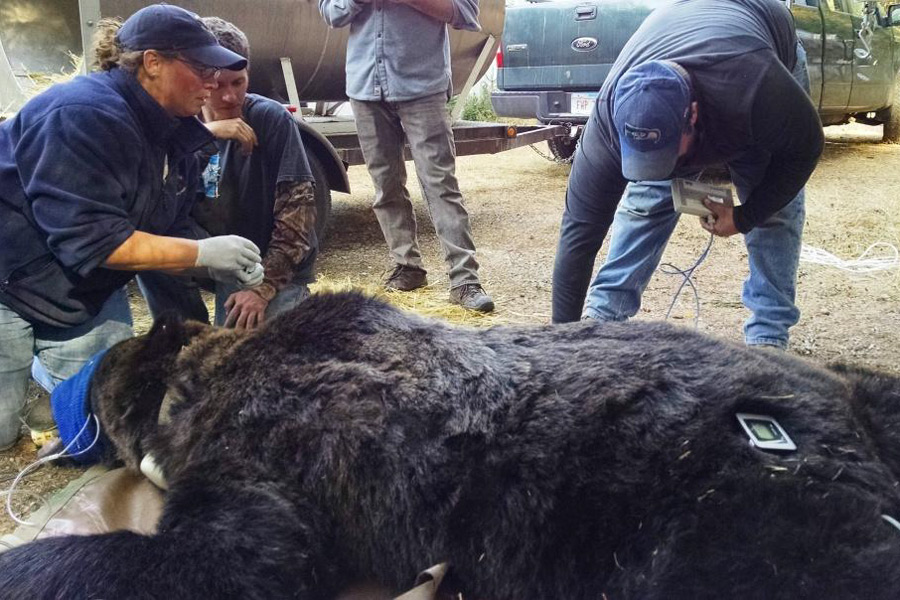Finally, there’s some good news out of bear country.
Following a spate of bear-human conflicts in Northwest Montana, including a fatal mauling near Kalispell, an attack in Glacier National Park, a believe-it-or-not encounter involving a man’s forearm and a grizzly’s gullet in Choteau, and a charging grizzly shot dead north of Olney, one recent grizzly encounter has prompted some cause for celebration.
On Oct. 5, a 500-pound male bruin was captured south of Libby after it cleared a non-functioning electric fence that was fortifying a beekeeper’s honey supply.
And while being caught with its paw in the honey jar is classic bad bear behavior, this 6.5-year-old grizzly’s journey to get to the Cabinet Mountains makes him special. It makes him the first documented bear to cross from the Yaak Mountains to the Cabinets in history, which is a boon for bolstering the isolated and relatively scant Cabinet Mountain grizzly population and promoting better genetic diversity there.
“It’s definitely some good news,” said Wayne Kasworm, the U.S. Fish and Wildlife Service recovery coordinator in Libby, whose efforts to augment the sparse grizzly populations in the Cabinet-Yaak Mountains of Northwest Montana by transplanting bears has finally begun to take hold. “This at least shows that a bear can get from the Yaak to the Cabinets on its own. The most important thing now is for that genetic interchange. He’s gotten there, now he needs to produce some offspring. It’s the gene flow that we want to see. That is what really links these populations.”
The U.S. Fish and Wildlife Service began its monitoring program in the early 1990s, when grizzlies were struggling to find purchase in the Cabinet-Yaak ecosystem. Its previous capture records show that the bear was born in the Yaak in 2009, and was subsequently captured and collared as a 2-year-old in 2011 as part of the monitoring program. The bear’s GPS collar dropped off in late 2012, and between 2013 and 2015, it crossed from the Yaak area to the Cabinet Mountains.
“We have been waiting for a bear to make the decision to go from one population to another, but it’s never been documented before, not for a native bear,” said Kim Annis, the Cabinet-Yaak bear management specialist for Montana Fish, Wildlife and Parks.
It is also the first grizzly to be captured this year for management reasons in the Cabinet-Yaak ecosystem, which with a total population of around 50 bears, and a projected rate of growth of 1.4 percent annually, pales in comparison to the robust Northern Continental Divide Ecosystem and the Greater Yellowstone Ecosystem, both of which have more than 1,000 bears and are growing at an annual rate of roughly 3 percent.
But more isolated populations of grizzly bears, which were listed as threatened under the U.S. Endangered Species Act in 1975, exist in more isolated habitats like the Cabinet-Yaak, where wildlife officials have been transplanting bears from more bear-dense areas to maintain genetic diversity and make up for mortalities, both natural and unnatural.
And so it is that a piece of good news is followed with bad.
At some point this summer, one of Kasworm’s transplant grizzlies – a 2-year-old Whitefish Range grizzly trapped and relocated to the Cabinet Mountains to shore up that population of breeding males – wandered into northern Idaho, having apparently gotten lost, but who Kasworm believes traveled there due in part to wildfires.
The bear was in an area north of Wallace and Kellogg, Idaho, posting out for as much as a month when a black bear hunter shot it in a case that the hunter claimed was mistaken identity. The case is still under investigation
“So that wasn’t such good news,” Kasworm said. “The idea is we are bringing in some unrelated males to reintroduce some genetic diversity, and we intend to provide even more. But every bear mortality is a blow.”
Another grizzly was shot dead north of Upper Whitefish Lake when it apparently charged a group of individuals that included a man and his young child.
According to a press release from FWP, the man told investigators that he and two other individuals were walking down an old logging road north of Olney and smelled something decomposing below the road. Their dog ran down and encountered a bear, then ran back toward the men with the bear on its tail. The men yelled at the bear, which then charged one of them.
One of the men shot the bear with a high-powered rifle and the bruin came to rest about 10 feet from the other.
Wardens found a large dead male grizzly, estimated at 500 pounds, and an elk carcass that had apparently been cached by the bear, according to officials. The case is under investigation.
And while bear managers continue to respond to an estimated 35-45 reports of bear activity every day – a call volume that probably won’t slow until mid-November when the bears den up for winter – the most tragic news came out of the Ashley Lake area earlier this month.
An elderly woman, 85-year-old Barbara Paschke, was fatally attacked inside her home near Ashley Lake. Paschke, who suffered from Alzheimer’s disease, according to her obituary, had been feeding bears in the area for quite some time. She died several days after the attack at a Kalispell hospital.
